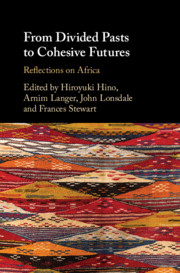Book contents
- From Divided Pasts to Cohesive Futures
- From Divided Pasts to Cohesive Futures
- Copyright page
- Contents
- Figures
- Tables
- Contributors
- Foreword
- Acknowledgments
- Introduction: Understanding Processes of Change in Social Cohesion: Learning from Comparative History
- Part I Social Cohesion in Africa: Case Studies of Past and Present
- Part II Policies and Institutions for Social Cohesion
- 6 Redressing Inequalities in Societies
- 7 Vertical and Horizontal Decentralisation for Equity and Stability
- 8 Land Reform
- 9 Protecting Education from Ethnic Politics
- 10 Building Social Cohesion through Education in Africa? Lessons from Côte d’Ivoire and Kenya
- 11 Remaking Cape Town
- 12 Key Ingredients of Inclusive Politics
- Part III Conclusions and Policy Recommendations
- Index
- References
11 - Remaking Cape Town
Memory Politics, Land Restitution, and Social Cohesion in District Six
from Part II - Policies and Institutions for Social Cohesion
Published online by Cambridge University Press: 05 August 2019
- From Divided Pasts to Cohesive Futures
- From Divided Pasts to Cohesive Futures
- Copyright page
- Contents
- Figures
- Tables
- Contributors
- Foreword
- Acknowledgments
- Introduction: Understanding Processes of Change in Social Cohesion: Learning from Comparative History
- Part I Social Cohesion in Africa: Case Studies of Past and Present
- Part II Policies and Institutions for Social Cohesion
- 6 Redressing Inequalities in Societies
- 7 Vertical and Horizontal Decentralisation for Equity and Stability
- 8 Land Reform
- 9 Protecting Education from Ethnic Politics
- 10 Building Social Cohesion through Education in Africa? Lessons from Côte d’Ivoire and Kenya
- 11 Remaking Cape Town
- 12 Key Ingredients of Inclusive Politics
- Part III Conclusions and Policy Recommendations
- Index
- References
Summary
District Six has been the site for imprinting new South African imaginaries onto real estate development, through new forms of compromise and accommodation. As attachments to inner city land have been asserted through land restitution or declarations of its historic significance, these claims have been contained through planning agendas that have prioritised mixed-use development, speculation and gentrification. As the state tries to imprint a development framework fragmented between themed environments of land restitution, commerce and the business of property, the District Six Museum has contested the field of memory, with new approaches to redefining citizenship in the post-apartheid city. Alongside civic forums, the museum has challenged the projects of urban regeneration, renewal and orderly citizenship that the state has inaugurated, demonstrating that social cohesion and urban reconstruction need to be based upon memory work, especially about the social experience of those whose material traces apartheid sought to destroy.
- Type
- Chapter
- Information
- From Divided Pasts to Cohesive FuturesReflections on Africa, pp. 346 - 374Publisher: Cambridge University PressPrint publication year: 2019
References
- 1
- Cited by

